Red deer indentation
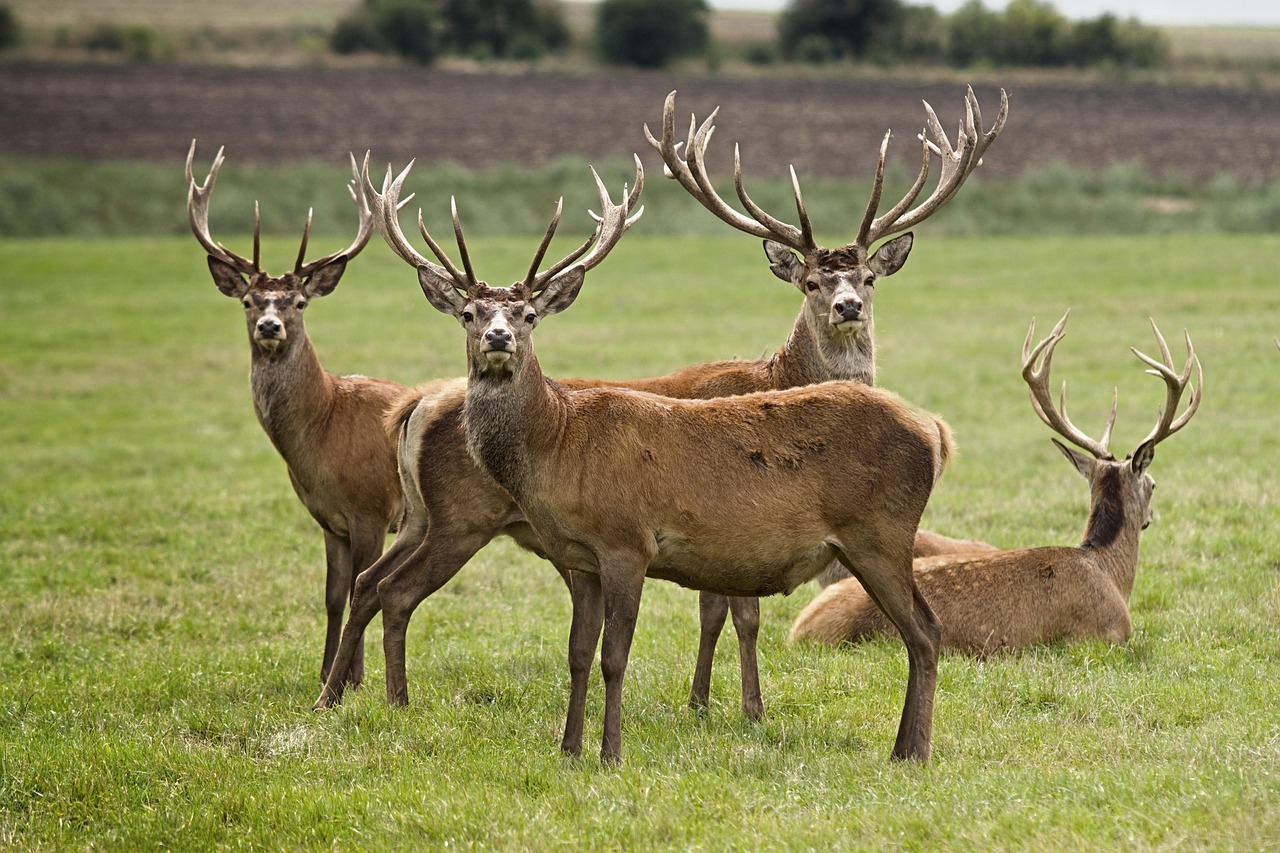
Next after the moose, the red deer is Europe’s largest deer species. It used to have a distribution up to central Sweden. But due to intensive hunting, the species was on the brink of extinction a century ago. A small remnant was saved on a few estates in Skåne. As recently as the mid-1900s, only a few hundred red deer remained, all in Skåne. From there, animals were later transferred to enclosures and released in places where red deer had previously existed. In addition to these releases, red deer of other origins have also been released or have escaped in various parts of the country. There is also migration from Norway.
Largely thanks to the creation of new management areas with planned culling, the species has in recent years shown strong development and has proven able to establish viable populations even in Swedish forest environments. The species now occurs in suitable locations throughout Götaland and southern Svealand, and here and there in Norrland.
Male red deer are called “hjort” or “kronhjort” (stag or red stag). Females that have not had offspring are called “smaldjur” (young hind), and after that “hind” or “kronhind”. Offspring are called “kalv” or “kronkalv”, sometimes “hjortkalv” (stag calf) and “hindkalv” (hind calf).
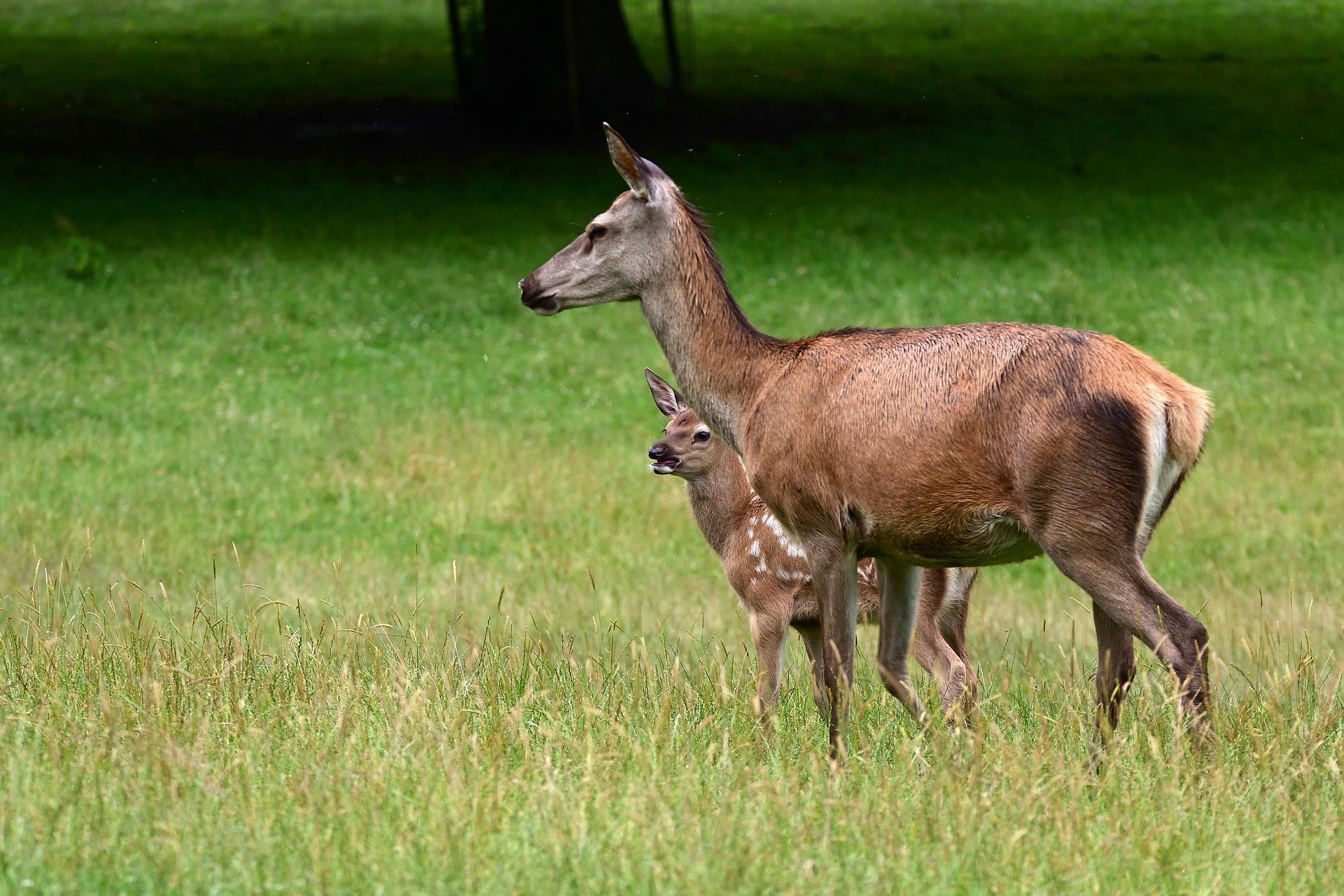
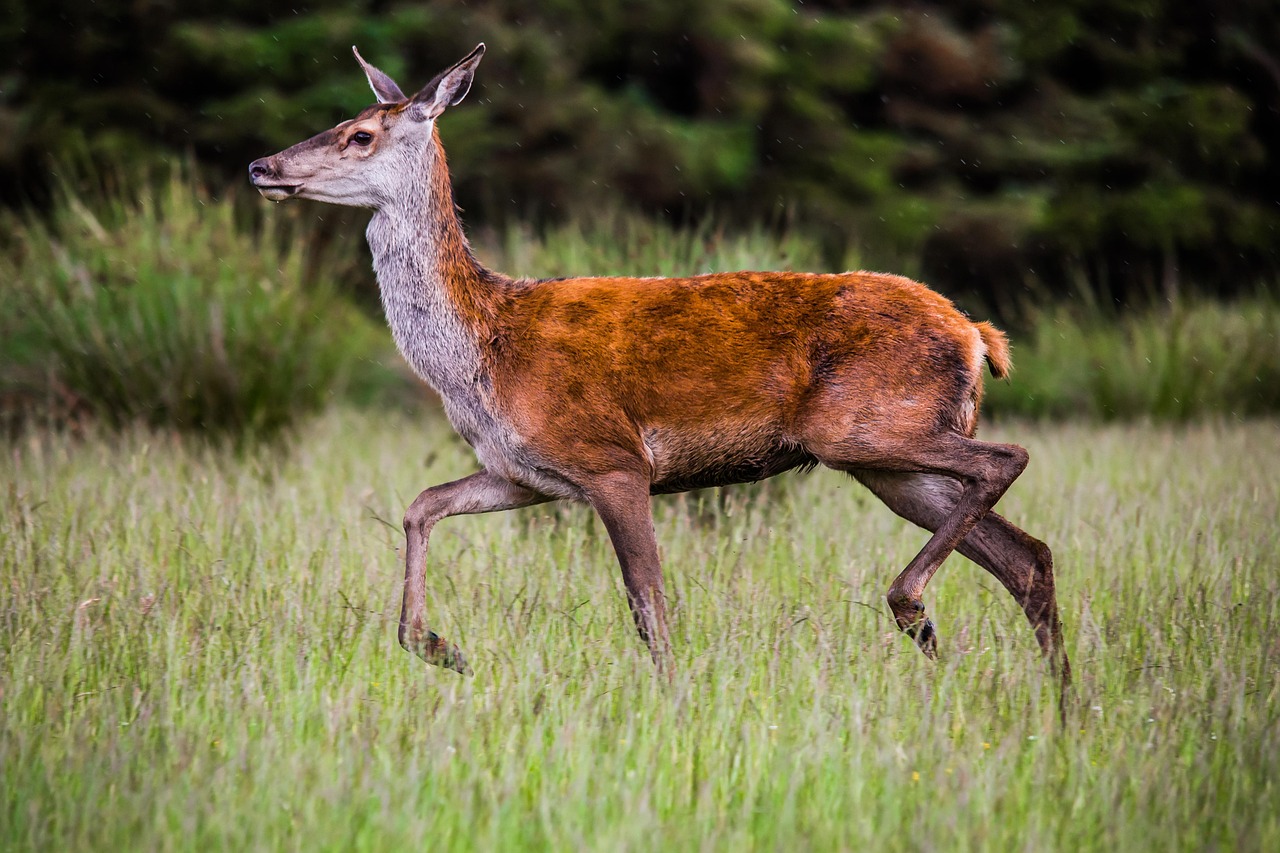
Characteristics
The summer coat is short-haired and reddish brown, but during the first two months the calf is white-spotted. The winter coat is longer-haired and dark gray-brown. The rump patch is yellowish white-beige, and the 12–15 cm long tail is relatively much shorter than that of the fallow deer and has on the upper side the same color as the rest of the coat. Red deer also usually keep the tail still.
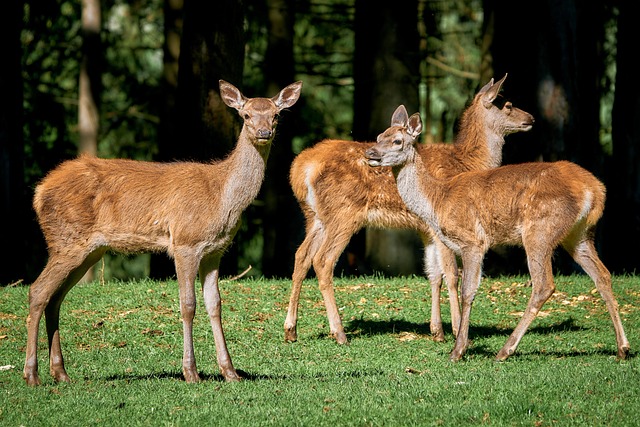
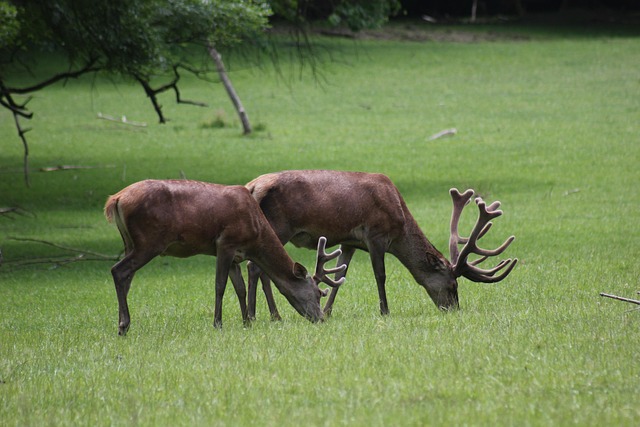
Throughout the hunting season, the stag carries antlers. They grow out during spring and summer, are rubbed clean in August, and are shed in March–April. In its second year of life, the young stag usually has only two points and is then called a “spike stag”.
The next antler set often has two or three, but can have as many as five or six, tines on each side. A red stag with six tines on each antler is called a “fork stag”. A stag with six tines on each antler is called an “even twelve-pointer”. If it has six tines on one antler and fewer, for example five, on the other, it is an “uneven twelve-pointer”. In the same way, stags are referred to as even or uneven eight-pointers, sixteen-pointers, and so on.
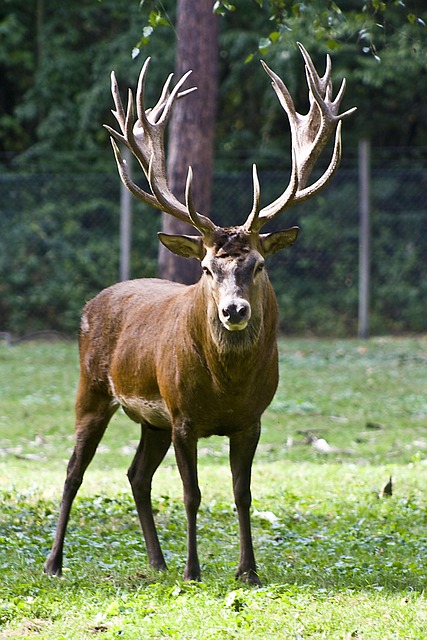
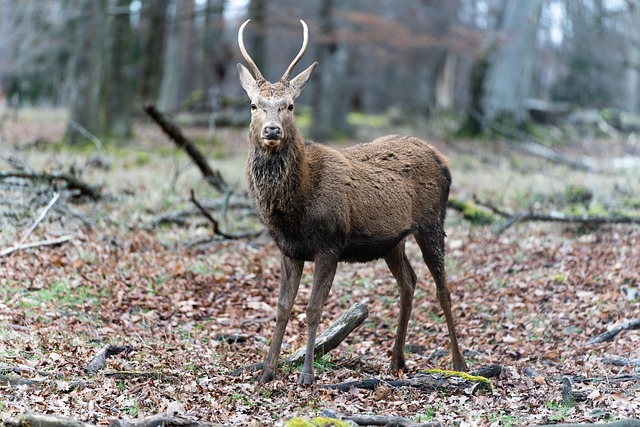
A fully developed antler set is not reached until the stag is about twelve years old. At that point, it is called “capital”. The tines at the tips of the antlers on a stag with twelve or more tines are shaped into the characteristic “crown” that gave the species its name.
The females have a noticeably long snout, which becomes more pronounced and tight with age. An old hind can therefore fairly easily be distinguished from a young hind or smaldjur by the shape of the head.
Characteristic for both sexes at all ages is their movement. Red deer can flee in bounds, but usually move off in an elegant, flowing trot, which most closely resembles that of a moose.
Habitat and behavior
Even though red deer are able to adapt to pure forest environments, the ideal habitat is a mixed landscape with alternating deciduous and mixed forest and cultivated land. Damp areas such as reed-edged lakeshores and marshes are highly favored.
Food is mainly gathered from the ground layer and consists of grass, herbs, lichens, heather, and berry shrubs. Red deer also browse buds and shoots of deciduous trees and bushes, and peel bark from spruce, ash, aspen, and young pine, which means they can also cause forest damage. Especially in southern Sweden, red deer destroy a lot of forest by stripping bark in spruce plantations. Red deer can also cause crop damage to cereals, root vegetables, sugar beets, and potatoes. Rapeseed fields are particularly attractive during the early summer flowering period.
Red deer is a hardy species that normally has no problem coping with a typical Swedish winter. But in severe snowy winters, or when one wants to divert the deer’s foraging away from sensitive areas, supplemental feeding may be necessary.
Originally, red deer were diurnal. But due to disturbances from humans and their activities, this shy game species is now primarily active at night. However, in the early mornings, it is still often possible to see red deer out in fields and at forest edges.
The hinds are very site-faithful, but stags can travel far from the place where they were born. For most of the year, red deer live in small groups, often a family group consisting of a hind, her calf and yearling, and sometimes an additional hind with calf. Family groups may join into larger herds under the leadership of an old and experienced lead hind. Young stags may sometimes be part of such a herd. The older stags keep to themselves, either alone or with a few others, sometimes many miles from their rutting areas and the hinds.
Red deer are shy and sensitive to disturbance, with sharp senses. Smell, hearing, and sight are well developed. The hunter must remain well concealed in their spot to avoid being detected by the lead hind’s sharp gaze. In case of danger, the animals emit a sharp bark or a coughing sound.
Rutting and reproduction
During the rut, the old stags seek out their rutting areas. These are usually areas with good cover and forage, where the hinds and their calves reside.
The rut begins in late August and continues into October. The dominant stag, the territory-holder (platshjorten), tries to gather a group of hinds and keeps other stags at a distance through intense roaring and aggressive behavior. Stags of equal strength may engage in violent battles that sometimes end in the death of one of them.
Red stags can begin holding territory already at six to eight years of age, but they usually don’t reach full maturity (capital antlers) until 10–14 years. After that, they decline quickly and usually don’t live much longer.
The hind reaches sexual maturity in her second year. The gestation period is eight months. She gives birth to only one calf, in April–May. Twin births are very rare, which means the species is less productive than both moose and roe deer.
Tracks and hunting
The track print is eight to nine centimeters long and six to seven centimeters wide, with imprints of the dewclaws behind. Common signs of red deer are stripped bark on trees, antler rubbing marks, and wallowing pits where the animals have rolled — so-called mud baths. The droppings appear in piles and are small, with one pointed end.
When managing a red deer population, one-third to half of the harvested animals should be calves. The remaining animals should be evenly distributed between sexes. The guideline should be to shoot the youngest (young hinds and spike stags) and the oldest (old hinds, except lead hinds, and a few capital stags). In a healthy red deer population, there should be stags of all ages.
Red deer are hunted in several different ways, partly depending on population density, and the local hunting culture. Stand hunting and stalking are practiced everywhere, while driven hunts and pressure hunts, as well as hunting with short-ranging dogs, mainly belong to Skåne and the Mälaren regions. In more heavily forested areas, hunting with slow-driving dogs also occurs. Only rifles in class 1 may be used. Regardless of hunting method, the law requires that a trained dog must be available to track any potentially wounded red deer.
Diseases in red deer
Our Swedish red deer population is relatively free from disease. Avian tuberculosis is, however, fairly common and causes pus-filled lesions in the liver, spleen, and lymph nodes. Another infectious disease is pseudotuberculosis, which also causes pus-filled abscesses in internal organs and lymph nodes. Pseudotuberculosis is transmitted via rodents and dirty feeding sites where the bacteria can occur in large quantities in the feed.
Infections with brainworm are fairly common in red deer. The parasite is usually seen between muscles but can also be found in the spinal canal. In the muscles, the worm appears as a black, approximately five-centimeter-long thread inside a greenish jelly-like mass. Brainworm in the spinal canal leads to movement disorders and other neurological symptoms. The parasite is not transmitted to humans or dogs.
A parasite seen in red stags is a roundworm, which appears as centimeter-long, cigar-shaped worms under the skin.
Summary
- A red stag becomes capital (fully mature) only at around twelve years of age.
- Red deer search for a large part of their food in the ground layer, but also eat twigs and buds from trees.
- In southern Sweden, red deer cause damage by stripping bark in spruce plantations.
- Red deer are most active during the night and early in the morning.
- Hinds are site-faithful, but stags travel long distances to and from rutting areas.
- All senses, including vision, are well developed in red deer.
- The rut in red deer mainly takes place in September. Calves are born in April–May.
- A red hind gives birth to only one calf per year.
- When managing a red deer population, almost half of the harvested animals should be calves.
